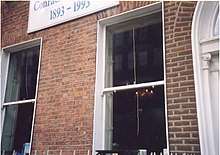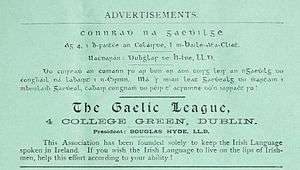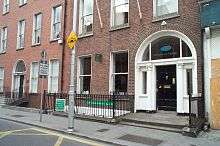Conradh na Gaeilge
Conradh na Gaeilge (Irish pronunciation: [ˈkɔn̪ˠɾˠə nə ˈɡeːlʲɟə]; historically known in English as the Gaelic League) is a social and cultural organisation which promotes the Irish language in Ireland and worldwide. The organisation was founded in 1893 with Douglas Hyde as its first president, when it emerged as the successor of several 19th century groups such as the Gaelic Union. The organisation would be the spearhead of the Gaelic revival and Gaeilgeoir activism. Originally the organisation intended to be apolitical, but many of its participants became involved in Irish nationalism.
 Logo of Conradh na Gaeilge | |
| Abbreviation | CnaG |
|---|---|
| Formation | 31 July 1893 |
| Founder | Douglas Hyde |
| Type | Non-governmental organisation |
| Headquarters | 6 Harcourt Street Dublin 2 Ireland |
| Fields | Irish language promotion Gaelic revival |
Secretary General | Julian de Spáinn |
President | Dr. Niall Comer |
| Subsidiaries | Raidió Rí-Rá |
| Website | cnag.ie |
Formerly called | Gaelic League |
History


Bruce Stewart suggests that an address by Douglas Hyde "led to the formation of the Gaelic League" with Hyde as the president.[1] The address titled ‘The Necessity for De-Anglicising Ireland’ was delivered by Hyde to the Irish National Literary Society, on 25 November 1892. (Thereafter, it was published in The Revival of Irish Literature, 1894.) Conradh na Gaeilge was founded in Dublin on 31 July 1893 by Douglas Hyde, the son of a Church of Ireland rector from Frenchpark, County Roscommon with the aid of Eugene O'Growney, Eoin MacNeill, Thomas O'Neill Russell and others. The organisation developed from Ulick Bourke's earlier Gaelic Union and became the leading institution promoting the Gaelic Revival, carrying on efforts like the publishing of the Gaelic Journal. The League's first newspaper was An Claidheamh Soluis (The Sword of Light) and its most noted editor was Pádraig Pearse. The motto of the League was Sinn Féin, Sinn Féin amháin (Ourselves, Ourselves alone).[2]
The League encouraged female participation from the start and a number of women played a prominent role. They were not restricted to subordinate roles, but played an active part in leadership, although males were in the overwhelming majority. Local notables, such as Lady Gregory in Galway, Lady Esmonde in County Wexford, and Mary Spring Rice in County Limerick, and others such as Máire Ní Shúilleabháin and Norma Borthwick who founded and led branches in her community. At the annual national convention in 1906 women were elected to seven of the forty-five positions on the Gaelic League executive. Executive members included Máire Ní Chinnéide, Úna Ní Fhaircheallaigh (who wrote pamphlets on behalf of the League), Bean an Doc Uí Choisdealbha, Máire Ní hAodáin, Máire de Buitléir, Nellie O'Brien, Eibhlín Ní Dhonnabháin, Eibhlín Nic Niocaill, and Eibhlín Nic Néill.[3][4]
Though apolitical, the organisation attracted many Irish nationalists of different persuasions, much like the Gaelic Athletic Association. It was through the League that many future political leaders and rebels first met, laying the foundation for groups such as the Irish Volunteers (1913). However, Conradh na Gaeilge did not commit itself entirely to the national movement until 1915, whereupon Douglas Hyde resigned as president, feeling that the culture of language should be above politics. Most of the signatories of the 1916 Proclamation were members. It still continued to attract many Irish Republicans. Seán MacStiofáin, the first chief of staff of the Provisional IRA was a prominent member in his later life.
League in the Free State
After the foundation of the Irish Free State in 1922, the organisation had a less prominent role in public life as Irish was made a compulsory subject in state-funded schools.[5] It did unexpectedly badly in the 1925 Irish Seanad election, when all the candidates it endorsed were defeated, including Hyde.[6]
In 1927, An Coimisiún Le Rincí Gaelacha (CLRG) was founded as a subcommittee of the League to investigate the promotion of traditional Irish dance. Eventually, CLRG became a largely independent organisation, though it is required by its constitution to share 3 board members with the League.[7]
Contemporary times
Conradh na Gaeilge, in alliance with other groups such as Gluaiseacht Chearta Sibhialta na Gaeltachta, was instrumental in the community campaigns which led to the creation of RTÉ Raidió na Gaeltachta (1972), Údarás na Gaeltachta (1980), and TG4 (1996). The organisation successfully campaigned for the enactment of the Official Languages Act, 2003 which gave greater statutory protection to Irish speakers and created the position of An Coimisinéir Teanga (The Languages Commissioner). Conradh na Gaeilge was among the principal organisations responsible for co-ordinating the successful campaign to make Irish an official language of the European Union.[8]

In 2008 during the presidency of Dáithí Mac Cárthaigh, Conradh na Gaeilge adopted a new constitution reverting to its pre 1915 non-political stance restating its aim as that of an Irish-speaking Ireland "Is í aidhm na hEagraíochta an Ghaeilge a athréimniú mar ghnáththeanga na hÉireann" ("It is the aim of the Organization to reinstate the Irish language as the everyday language of Ireland") and dropping any reference to Irish freedom.
In recent years Conradh na Gaeilge has remained central to campaigns to protect language rights throughout Ireland. This strategy encompasses the promotion of increased investment in Gaeltacht areas,[9] advocacy for increased provision of state services through Irish,[10] the development of Irish language hubs in urban areas, and the Acht Anois campaign for the enactment of an Irish Language Act to protect the language in Northern Ireland.[11]
Branches
According to the organization's constitution;[12] The branch is the primary unit of the organisation. Conradh na Gaeilge has listed the present branches in Ireland as follows on its website;[13]
Ulster (including County Louth)
- Fermanagh 1 branch recorded -Craobh Lios na Scéithe
- Monaghan, 2 branches recorded - Craobh Charraig Mhachaire Rois and Craobh Chluain Eois
- Tyrone, 11 branches recorded- Craobh an tSratha Báin, Craobh Ard Bó, Craobh Chabhán an Chaorthainn,Craobh Chaisleán na Deirge, Craobh Chluain Eo, Craobh Loch Mhic Ruairí, Craobh na Carraige Móire, Craobh Phort an Dúnáin, Craobh Rua Dhún Geanainn, Craobh Ruairí Mhic Easmainn, and Craobh Port Mór
- Louth, 2 branches recorded- Craobh Chrois Mhic Lionnáin and Craobh Dhún Dealgan[14]
Leinster (excluding County Louth)
- Laois, 1 branch recorded- Craobh Thomáis Uí Dhuibhir
- Longford, 1 branch recorded- Craobh an Longfoirt
- Meath, 7 branches recorded- Craobh Bhaile Ghib. Craobh Bhaile Átha Troim, Craobh Cholmcille, Craobh na hUaimhe, Craobh na nAisteoirí, Craobh Ráth Chairn, Craobh Átha Buí
- Offaly, 1 branch recorded- Craobh na Tulaí Móire
- Wicklow, 1 branch recorded, Craobh iMeasc[14]
Munster
- Limerick, 4 branches recorded- Cumann Gaelach Choláiste Mhuire Gan Smál, Craobh an Chaisleán Nua, Craobh Luimnigh
- Tipperary. 7 branches recorded-Craobh an Aonaigh, Craobh Bhaile Thiobraid Árainn, Craobh Chaiseal Mumhan, Craobh Dhúrlas Éile, Craobh Ros Cré, Craobh Uí hIcí, Cumann Gaelach Chluain Meala.
- Waterford, 3 branches recorded- Craobh Dhún Garbhán, Craobh Rinn Ó gCuanach and Cumann Gaelach IT Phort Láirge[14]
Connacht
- Leitrim, 1 branch recorded- Craobh Thomáis Uí Dhuibhir
- Mayo, 8 branches recorded- Craobh Achadh Mór, Craobh Bhall Álainn, Craobh Bhéal an Átha, Craobh Chaisleán a Bharraigh, Craobh Chlár Chlainne Mhuiris, Craobh Contae Mhaigh Eo, Craobh Thuar Mhic Éadaigh, Craobh Uileog de Búrca.* Kilkenny, 1 branch recorded-Craobh Chill Chainnigh
- Roscommon, 1 branch recorded- Craobh Ros Comáin
- Sligo, 2 branches recorded- Coláiste San Aingeal and Craobh Dhúiche Cholmáin[14]
Presidents
- 1893–1915, Douglas Hyde
- 1916–1919, Eoin Mac Néill
- 1919–1922, Seán Ua Ceallaigh
- 1922–1925, Peadar Mac Fhionnlaoich
- 1925–1926, Seán P. Mac Énrí
- 1926-1928, Cormac Breathnach
- 1928–1933, Mac Giolla Bhríde
- 1933–1940, Peadar Mac Fhionnlaoich
- 1940–1941, Liam Ó Buachalla
- 1941–1942, Seán Óg Ó Tuama
- 1942–1945, Diarmuid Mac Fhionnlaoich
- 1945–1946, Seán Mac Gearailt
- 1946–1949, Liam Ó Luanaigh
- 1949–1950, Diarmuid Mac Fhionnlaoich
- 1950–1952, Annraoi Ó Liatháin
- 1952–1955, Seán Mac Gearailt
- 1955–1959, Tomás Ó Muircheartaigh
- 1959–1965, Micheál Mac Cárthaigh
- 1965–1968, Cathal Ó Feinneadha
- 1968–1974, Maolsheachlainn Ó Caollaí
- 1974–1979, Pádraig Ó Snodaigh
- 1979–1982, Albert Fry
- 1982–1985, Micheál Ó Murchú
- 1985–1989, Íte Ní Chionnaith
- 1989–1994, Proinsias Mac Aonghusa
- 1994–1995, Áine de Baróid
- 1995-1998, Gearóid Ó Cairealláin
- 1998–2003, Tomás Mac Ruairí
- 2003–2004, Séagh Mac Siúrdáin
- 2004–2005, Nollaig Ó Gadhra
- 2005–2008, Dáithí Mac Cárthaigh
- 2008–2011, Pádraig Mac Fhearghusa
- 2011–2014, Donnchadh Ó hAodha
- 2014–2017, Cóilín Ó Cearbhaill[15]
- 2017–present, Niall Comer
References
- Stewart, Bruce (2000). "On the Necessity of De-Hydifying Irish Cultural Criticism". New Hibernia Review / Iris Éireannach Nua. 4 (1): 23.
- Murphy, Brian P. (2005). The Catholic Bulletin and Republican Ireland: with special reference to J. J. O'Kelly ('Sceilg'). London: Athol Books. pp. 51–53. ISBN 0-85034-108-6.
- New Hibernia Review. 6:1 Spring 2002. pp 57–62
- Irish Peasant, 18 August 1906
- "The Gaelic League in the Irish Free State in the 1920s and 1930s". The Irish Story. 28 November 2015.
- Coakley, John (September 2005). "Ireland's Unique Electoral Experiment: The Senate Election of 1925". Irish Political Studies. 20 (3): 231–269. doi:10.1080/07907180500359327.
- Cullinane, John (2003). An Coimisiún Le Rince Gaelacha: its origins and evolution. Dublin: Dr John P Cullinane. ISBN 0952795248.
- Cinneadh an AE: Céim fhíorthábhachtach stairiúil don Ghaeilge, go hidirnáisiúnta agus in Éirinn Archived 22 March 2007 at the Wayback Machine (Irish language) Foras na Gaeilge press release, 13 June 2005.
- "Plean Infheistíochta Le 1,160+ Post A Chruthú & Deiseanna Úsáidte Gaeilge don Phobal Á Nochtadh Inniu - Conradh na Gaeilge | Ar son phobal na Gaeilge". cnag.ie (in Irish). Retrieved 30 September 2017.
- "Irish-Language Rights On The Elections' Agenda - Conradh na Gaeilge | Ar son phobal na Gaeilge". cnag.ie. Retrieved 30 September 2017.
- "Irish-Language Act - Conradh na Gaeilge | Ar son phobal na Gaeilge". cnag.ie. Retrieved 30 September 2017.
- The Constitution of Conradh na Gaeilge|https://cnag.ie/en/info/conradh-na-gaeilge/constitution.html
- Official website|https://www.cnag.ie/en/
- "Branch Locator - Conradh na Gaeilge | Ar son phobal na Gaeilge". cnag.ie. Retrieved 5 February 2020.
- "Ã Cearbhaill elected as President of Conradh na Gaeilge". gaelport.com.
Bibliography
- Mac Aonghusa, Proinsias (1993). Ar son na Gaeilge: Conradh na Gaeilge 1893-1993. Conradh na Gaeilge. ASIN B001A49CUY.CS1 maint: ref=harv (link)
- Mac Fhearghusa, Pádraig (1995). Conradh na Gaeilge i gCiarrai. Conradh na Gaeilge. ASIN B0010DRN88.CS1 maint: ref=harv (link)
- Mac Giolla Domhnaigh, Gearóid (1995). Conradh Gaeilge Chúige Uladh ag tús an 20ú chéid. Comhaltas Uladh de Chonradh na Gaeilge. ISBN 0951726412.CS1 maint: ref=harv (link)
- O'Riordain, Traolach (2000). Conradh na Gaeilge i gCorcaigh 1894-1910. Cois Life Teoranta. ISBN 1901176177.CS1 maint: ref=harv (link)
- Ó Súilleabháin, Donncha (1989). Conradh na Gaeilge i Londain 1894-1917. Conradh na Gaeilge. ASIN B009QZETH0.CS1 maint: ref=harv (link)
External links
![]()